
Concept explainers
(a)
Interpretation:
The specific relationship between the pair of molecules shown is to be determined.
Concept introduction:
The intersection of a horizontal and vertical line indicates a carbon atom- typically an asymmetric carbon. The atom at the intersection is a carbon atom. The substituents on the vertical bonds point away from the observer while those on the horizontal bonds point toward the observer.
To determine the R/S configuration at the asymmetric carbon (chiral center), the vertical bonds are replaced by dash bonds and horizontal ones by wedge bonds. The groups on these bonds are then assigned priorities according to Cahn-Ingold-Prelog rules. If the priority groups 1 to 3 are arranged clockwise with the lowest priority group pointing away (at the back), the configuration of the asymmetric carbon is R. If they are arranged counterclockwise, the configuration is S.
If the lowest priority group is pointing toward the observer (it is in the front), then the actual configuration is reverse of that indicated. That means if the arrangement is clockwise, the actual configuration is S, and if counterclockwise, it is R.
If the molecules have different formulas, they are unrelated compounds. If the formulas are same, but the connectivity of atoms is different, the molecules are constitutional isomers.
If the formulas as well as connectivities are the same, then the molecules may be the same or stereoisomers.
The configuration of each asymmetric carbon is then compared to determine the specific relationship between the two molecules. If the configurations are the same, the molecules may be the same or conformers of the same molecule. Conformers are molecules that can be interconverted by a rotation about a single bond.
If the configurations at a single chiral center are different, then the two molecules are enantiomers.
If the molecule contains more than one chiral center, then a difference in the configuration of all chiral centers makes them enantiomers. If the configurations are different at some but not all the chiral centers, then the molecules are diastereomers.
Answer to Problem 5.73P
The molecules are the same.
Explanation of Solution
The Fischer projections are

After converting the Fischer projections to dash-wedge representation, it can be shown that the two are the same.
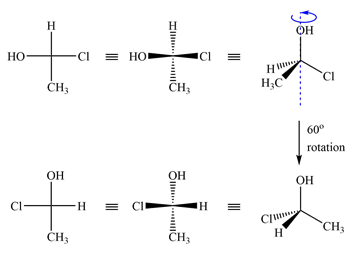
Rotating the first molecule through
Therefore, the two molecules are the same.
The two molecules are identical because rotating the dash-wedge structures interconverts them into each other.
(b)
Interpretation:
The specific relationship between the pair of molecules shown is to be determined.
Concept introduction:
The intersection of a horizontal and vertical line indicates a carbon atom- typically an asymmetric carbon. The atom at the intersection is a carbon atom. The substituents on the vertical bonds point away from the observer while those on the horizontal bonds point toward the observer.
To determine the R/S configuration at the asymmetric carbon (chiral center), the vertical bonds are replaced by dash bonds and horizontal ones by wedge bonds. The groups on these bonds are then assigned priorities according to Cahn-Ingold-Prelog rules. If the priority groups 1 to 3 are arranged clockwise with the lowest priority group pointing away (at the back), the configuration of the asymmetric carbon is R. If they are arranged counterclockwise, the configuration is S.
If the lowest priority group is pointing toward the observer (it is in the front), then the actual configuration is reverse of that indicated. That means if the arrangement is clockwise, the actual configuration is S, and if counterclockwise, it is R.
If the molecules have different formulas, they are unrelated compounds. If the formulas are same, but the connectivity of atoms is different, the molecules are constitutional isomers. If the formulas as well as connectivities are the same, then the molecules may be the same or stereoisomers.
The configuration of each asymmetric carbon is then compared to determine the specific relationship between the two molecules. If the configurations are the same, the molecules may be the same or conformers of the same molecule. Conformers are molecules that can be interconverted by a rotation about a single bond.
If the configurations at a single chiral center are different, then the two molecules are enantiomers.
If the molecule contains more than one chiral center, then a difference in the configuration of all chiral centers makes them enantiomers. If the configurations are different at some but not all the chiral centers, then the molecules are diastereomers.
Answer to Problem 5.73P
The two molecules are the same.
Explanation of Solution
The Fischer projections are

The first projection is converted into the second one by a simple rotation through
Rotating a Fischer projection in the plane of the paper does not change the configuration.
(c)
Interpretation:
The specific relationship between the pair of molecules shown is to be determined.
Concept introduction:
The intersection of a horizontal and vertical line indicates a carbon atom- typically an asymmetric carbon. The atom at the intersection is a carbon atom. The substituents on the vertical bonds point away from the observer while those on the horizontal bonds point toward the observer.
To determine the R/S configuration at the asymmetric carbon (chiral center), the vertical bonds are replaced by dash bonds and horizontal ones by wedge bonds. The groups on these bonds are then assigned priorities according to Cahn-Ingold-Prelog rules. If the priority groups 1 to 3 are arranged clockwise with the lowest priority group pointing away (at the back), the configuration of the asymmetric carbon is R. If they are arranged counterclockwise, the configuration is S.
If the lowest priority group is pointing toward the observer (it is in the front), then the actual configuration is reverse of that indicated. That means if the arrangement is clockwise, the actual configuration is S, and if counterclockwise, it is R.
If the molecules have different formulas, they are unrelated compounds. If the formulas are same, but the connectivity of atoms is different, the molecules are constitutional isomers.
If the formulas as well as connectivities are the same, then the molecules may be the same or stereoisomers.
The configuration of each asymmetric carbon is then compared to determine the specific relationship between the two molecules. If the configurations are the same, the molecules may be the same or conformers of the same molecule. Conformers are molecules that can be interconverted by a rotation about a single bond.
If the configurations at a single chiral center are different, then the two molecules are enantiomers.
If the molecule contains more than one chiral center, then a difference in the configuration of all chiral centers makes them enantiomers. If the configurations are different at some but not all the chiral centers, then the molecules are diastereomers.
Answer to Problem 5.73P
The two molecules are enantiomers.
Explanation of Solution
The Fischer projections are

The projections are converted to sash-wedge representations as shown below. The four groups on the chiral carbon are then assigned priorities according to Cahn-Ingold-Prelog rules.
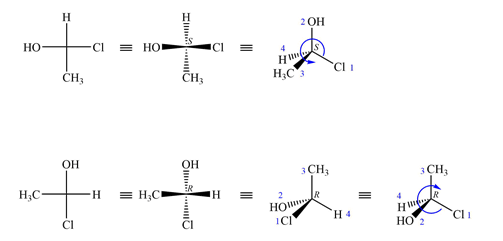
The priority 1 to 3 groups in the first molecule are arranged counterclockwise with the lowest priority H at the back. The configuration at this carbon is then S.
In the second molecule, these groups are arranged counterclockwise; therefore, its configuration is R, opposite that of the first molecule.
Therefore, the two molecules are enantiomers.
Molecules with a single chiral center are enantiomers if their configurations are different.
(d)
Interpretation:
The specific relationship between the pair of molecules shown is to be determined.
Concept introduction:
The intersection of a horizontal and vertical line indicates a carbon atom- typically an asymmetric carbon. The atom at the intersection is a carbon atom. The substituents on the vertical bonds point away from the observer while those on the horizontal bonds point toward the observer.
To determine the R/S configuration at the asymmetric carbon (chiral center), the vertical bonds are replaced by dash bonds and horizontal ones by wedge bonds. The groups on these bonds are then assigned priorities according to Cahn-Ingold-Prelog rules. If the priority groups 1 to 3 are arranged clockwise with the lowest priority group pointing away (at the back), the configuration of the asymmetric carbon is R. If they are arranged counterclockwise, the configuration is S.
If the lowest priority group is pointing toward the observer (it is in the front), then the actual configuration is reverse of that indicated. That means if the arrangement is clockwise, the actual configuration is S, and if counterclockwise, it is R.
If the molecules have different formulas, they are unrelated compounds. If the formulas are same, but the connectivity of atoms is different, the molecules are constitutional isomers.
If the formulas as well as connectivities are the same, then the molecules may be the same or stereoisomers.
The configuration of each asymmetric carbon is then compared to determine the specific relationship between the two molecules. If the configurations are the same, the molecules may be the same or conformers of the same molecule. Conformers are molecules that can be interconverted by a rotation about a single bond.
If the configurations at a single chiral center are different, then the two molecules are enantiomers.
If the molecule contains more than one chiral center, then a difference in the configuration of all chiral centers makes them enantiomers. If the configurations are different at some but not all the chiral centers, then the molecules are diastereomers.
Answer to Problem 5.73P
The two molecules are enantiomers.
Explanation of Solution
The Fischer projections of the molecules are

The molecules can be interconverted by exchanging the positions of two of the four groups,
Therefore these are enantiomer.
Exchanging positions of two of the four groups attached to an asymmetric carbon inverts its configuration.
(e)
Interpretation:
The specific relationship between the pair of molecules shown is to be determined.
Concept introduction:
The intersection of a horizontal and vertical line indicates a carbon atom- typically an asymmetric carbon. The atom at the intersection is a carbon atom. The substituents on the vertical bonds point away from the observer while those on the horizontal bonds point toward the observer.
To determine the R/S configuration at the asymmetric carbon (chiral center), the vertical bonds are replaced by dash bonds and horizontal ones by wedge bonds. The groups on these bonds are then assigned priorities according to Cahn-Ingold-Prelog rules. If the priority groups 1 to 3 are arranged clockwise with the lowest priority group pointing away (at the back), the configuration of the asymmetric carbon is R. If they are arranged counterclockwise, the configuration is S.
If the lowest priority group is pointing toward the observer (it is in the front), then the actual configuration is reverse of that indicated. That means if the arrangement is clockwise, the actual configuration is S, and if counterclockwise, it is R.
If the molecules have different formulas, they are unrelated compounds. If the formulas are same, but the connectivity of atoms is different, the molecules are constitutional isomers.
If the formulas as well as connectivities are the same, then the molecules may be the same or stereoisomers.
The configuration of each asymmetric carbon is then compared to determine the specific relationship between the two molecules. If the configurations are the same, the molecules may be the same or conformers of the same molecule. Conformers are molecules that can be interconverted by a rotation about a single bond.
If the configurations at a single chiral center are different, then the two molecules are enantiomers.
If the molecule contains more than one chiral center, then a difference in the configuration of all chiral centers makes them enantiomers. If the configurations are different at some but not all the chiral centers, then the molecules are diastereomers.
Answer to Problem 5.73P
The two molecules are enantiomers.
Explanation of Solution
The Fischer projections of the two molecules are
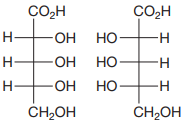
The molecules are aldonic acids with the same molecular formula and connectivity. Each contains three asymmetric carbons, C2, C3, and C4. Therefore, they can be the same molecules, conformers, or configurational isomers.
The two cannot be interconverted by a rotation about a single bond; therefore, they are not conformers.
The configurations of each of these three must be compared to determine the specific relation between the two molecules.
To determine the configurations of the three asymmetric carbons, the Fischer projection is redrawn as a dash-wedge structure at each carbon.
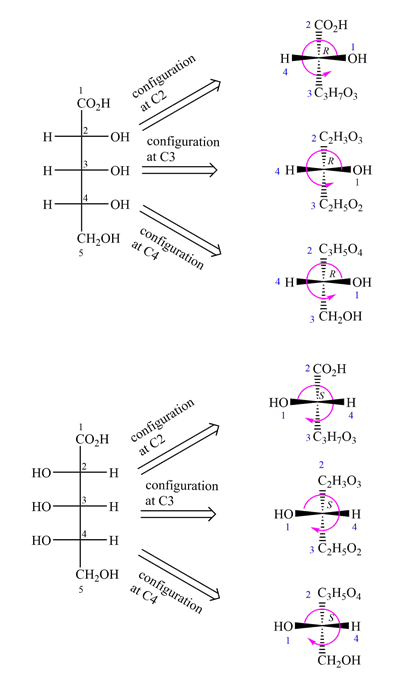
The vertical bonds in the Fischer projection are pointed away from the observer, while the horizontal ones are pointed toward the observer. The four groups attached to the asymmetric carbon are then assigned priorities according to Cahn-Ingold-Prelog rules. Based on the priorities, the configurations at the three asymmetric carbons in the first molecule are
Therefore, the two molecules are enantiomers.
When the configurations at every asymmetric carbon in the pair of molecules with the same formula and connectivity are different, the molecules are enantiomers.
(f)
Interpretation:
The specific relationship between the pair of molecules shown is to be determined.
Concept introduction:
The intersection of a horizontal and vertical line indicates a carbon atom- typically an asymmetric carbon. The atom at the intersection is a carbon atom. The substituents on the vertical bonds point away from the observer while those on the horizontal bonds point toward the observer.
To determine the R/S configuration at the asymmetric carbon (chiral center), the vertical bonds are replaced by dash bonds and horizontal ones by wedge bonds. The groups on these bonds are then assigned priorities according to Cahn-Ingold-Prelog rules. If the priority groups 1 to 3 are arranged clockwise with the lowest priority group pointing away (at the back), the configuration of the asymmetric carbon is R. If they are arranged counterclockwise, the configuration is S.
If the lowest priority group is pointing toward the observer (it is in the front), then the actual configuration is reverse of that indicated. That means if the arrangement is clockwise, the actual configuration is S, and if counterclockwise, it is R.
If the molecules have different formulas, they are unrelated compounds. If the formulas are same, but the connectivity of atoms is different, the molecules are constitutional isomers.
If the formulas as well as connectivities are the same, then the molecules may be the same or stereoisomers.
The configuration of each asymmetric carbon is then compared to determine the specific relationship between the two molecules. If the configurations are the same, the molecules may be the same or conformers of the same molecule. Conformers are molecules that can be interconverted by a rotation about a single bond.
If the configurations at a single chiral center are different, then the two molecules are enantiomers.
If the molecule contains more than one chiral center, then a difference in the configuration of all chiral centers makes them enantiomers. If the configurations are different at some but not all the chiral centers, then the molecules are diastereomers.
Answer to Problem 5.73P
The molecules are diastereomers.
Explanation of Solution
The Fischer projections of the two molecules are
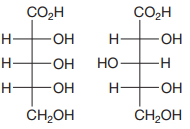
The molecules are aldonic acids with the same molecular formula and connectivity. Each contains three asymmetric carbons, C2, C3, and C4. Therefore, they can be the same molecules, conformers, or configurational isomers.
The two cannot be interconverted by a rotation about a single bond; therefore, they are not conformers.
The configurations of each of these three must be compared to determine the specific relation between the two molecules.
To determine the configurations of the three asymmetric carbons, the Fischer projection is redrawn as a dash-wedge structure at each carbon.
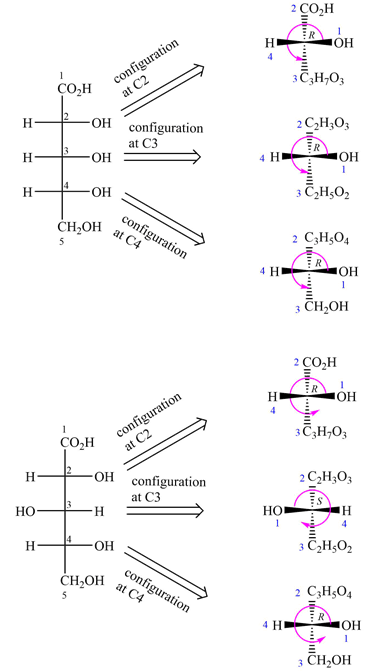
The vertical bonds in the Fischer projection are pointed away from the observer while the horizontal ones are pointed toward the observer. The four groups attached to the asymmetric carbon are then assigned priorities according to Cahn-Ingold-Prelog rules. Based on the priorities, the configurations at the three asymmetric carbons in the first molecule are
Therefore, the two molecules are diastereomers.
Two chiral molecules with multiple chiral centers that differ in configuration at some but not all chiral centers are diastereomers.
Want to see more full solutions like this?
Chapter 5 Solutions
Get Ready for Organic Chemistry
- Predict the intermediate 1 and final product 2 of this organic reaction: NaOMe H+ + 1 2 H H work up You can draw 1 and 2 in any arrangement you like. Note: if either 1 or 2 consists of a pair of enantiomers, just draw one structure using line bonds instead of 3D (dash and wedge) bonds at the chiral center. Click and drag to start drawing a structure. X $ dmarrow_forwardPredict the major products of this organic reaction: 1. NaH (20°C) 2. CH3Br ? Some notes: • Draw only the major product, or products. You can draw them in any arrangement you like. • Be sure to use wedge and dash bonds where necessary, for example to distinguish between major products that are enantiomers. • If there are no products, just check the box under the drawing area. No reaction. Click and drag to start drawing a structure. G Crarrow_forwardPredict the major products of this organic reaction: 1. LDA (-78°C) ? 2. Br Some notes: • Draw only the major product, or products. You can draw them in any arrangement you like. . • Be sure to use wedge and dash bonds where necessary, for example to distinguish between major products that are enantiomers. • If there are no products, just check the box under the drawing area. No reaction. Click and drag to start drawing a structure. Xarrow_forward
- Please draw the structuresarrow_forwardDraw the missing intermediates 1 and 2, plus the final product 3, of this synthesis: 0 1. Eto 1. Eto- 1 2 2. MeBr 2. EtBr H3O+ A 3 You can draw the three structures in any arrangement you like. Explanation Check Click and drag to start drawing a structure.arrow_forwardDraw the missing intermediate 1 and final product 2 of this synthesis: 1. MeO- H3O+ 1 2 2. PrBr Δ You can draw the two structures in any arrangement you like. Click and drag to start drawing a structure.arrow_forward
- What is the differences between: Glyceride and phosphoglyceride Wax and Fat Soap and Fatty acid HDL and LDL cholesterol Phospho lipids and sphingosine What are the types of lipids? What are the main lipid components of membrane structures? How could lipids play important rules as signaling molecules and building units? The structure variety of lipids makes them to play significant rules in our body, conclude breifly on this statement.arrow_forwardWhat is the differences between DNA and RNA for the following: - structure - function - type What is the meaning of: - replication - transcription - translation show the base pair connection(hydrogen bond) in DNA and RNAarrow_forwardWhat is the IP for a amino acid- give an example what are the types of amino acids What are the structures of proteins The N-Terminal analysis by the Edman method shows saralasin contains sarcosine at the N-terminus. Partial hydrolysis of saralasin with dilute hydrochloric acid yields the following fragments: Try-Val-His Sar-Arg-Val His-Pro-Ala Val- Tyr- Val Arg-Val-Tyr What is the structure of saralasin?arrow_forward
- What is the IP for a amino acid- give an example what are the types of amino acids What are the structures of proteins The N-Terminal analysis by the Edman method shows saralasin contains sarcosine at the N-terminus. Partial hydrolysis of saralasin with dilute hydrochloric acid yields the following fragments: Try-Val-His Sar-Arg-Val His-Pro-Ala Val- Tyr- Val Arg-Val-Tyr What is the structure of saralasin?arrow_forward> aw the missing intermediates 1 and 2, plus the final product 3, of this synthesis: 1. Eto 1. EtO¯ H3O+ 1 2 2. PrBr 2. PrBr Δ You can draw the three structures in any arrangement you like. 3 Click and drag to start drawing a structure. Explanation Check 2025 McGraw Hill LLC. All Rights Reserved. Terms of Use Privacarrow_forwardThere are various factors that affect an equilibrium. Give 3 of these factors and explain using examples andequations how an equilibrium is affected by these factors. Please remember that this is a communication question so that you are communicating your understanding of the factors that affect and equilibrium.arrow_forward
 Organic Chemistry: A Guided InquiryChemistryISBN:9780618974122Author:Andrei StraumanisPublisher:Cengage Learning
Organic Chemistry: A Guided InquiryChemistryISBN:9780618974122Author:Andrei StraumanisPublisher:Cengage Learning
